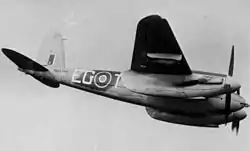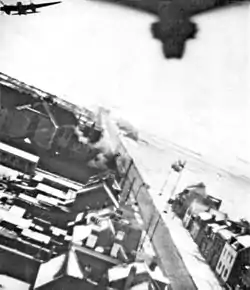No. 487 Squadron RNZAF
No. 487 (NZ) Squadron was a Royal New Zealand Air Force light-bomber squadron, formed under Article XV of the Empire Air Training Scheme during World War II. Established in mid-1942, the squadron served in the European theatre, under the operational command of the Royal Air Force. It operated the Lockheed Ventura and de Havilland Mosquito and took part in over 3,000 operational sorties before being disbanded at the end of the war in late 1945.
| No. 487 (NZ) Squadron RAF | |
|---|---|
 Mosquito MM417 EG-T of no. 487 Squadron RNZAF | |
| Active | 15 August 1942 – 19 September 1945 |
| Country | |
| Allegiance | |
| Branch | |
| Role | Bomber |
| Motto(s) | Māori: Ki te mutunga (Translation: "Through to the end")[1][2] |
| Anniversaries | 15 August 1942 |
| Insignia | |
| Squadron Badge | A tekoteko holding a bomb[1][2] |
| Squadron Codes | EG (Aug 1942 – Sep 1945)[1][3][4] |
| Aircraft flown | |
| Bomber | Lockheed Ventura de Havilland Mosquito |
History

No. 487 (NZ) Squadron came into being on 15 August 1942. Formed as a day bomber unit, it was initially equipped with Lockheed Venturas crewed by Royal New Zealand Air Force pilots, and based at RAF Feltwell in Norfolk.[2] The Ventura, an update of the Lockheed Hudson, acquired a poor reputation in Europe[5] as its performance was not really in the same league as British and German aircraft of the period. Nevertheless, operations began in December, with the squadron's first being a 16-plane raid on the Phillips factory at Eindhoven, in the Netherlands,[6][1] during which it lost three aircraft, including the one flown by its commanding officer, Wing Commander F.C. Seavill.[7]
Further operations followed, but disaster came on 3 May 1943, when an 11-aircraft Ramrod raid – one to be continued regardless of losses – against Amsterdam designated Operation Ramrod 16 resulted in the loss of all but one of the squadron's Venturas. After crossing the Dutch coast, the Venturas were bounced by a group of 70 to 80 German fighters. They penetrated the Spitfire escort and got in amongst 487 Squadron's bombers, damaging one and forcing it to return to base. The squadron pressed on, with further losses; by the time the Venturas had begun their bomb run, only five aircraft remained. The Germans then proceeded to pick them off, although they fought back as best they could, with Squadron Leader Leonard Trent downing one attacker with his machine-guns as the German fighter flew across his nose. Finally only Trent's aircraft remained in the air. Reaching the target, he pressed home his attack, dropping his payload – narrowly missing the target, but causing some damage – before he too was shot down.[8] For his leadership during the raid, Trent was later awarded the Victoria Cross. He survived being shot down and was taken prisoner; he later took part in the "Great Escape".[9]

Following this, No 487 was transferred to the 2nd TAF on 1 June 1943. It was slowly rebuilt and in August it began to receive Mosquito FB.Mk.VIs to replace its Venturas.[6] On 18 February 1944, the squadron took part in the raid on the Amiens prison during Operation Jericho, destroying a wall and enabling over a hundred Resistance prisoners, scheduled for execution, to escape. On 31 October 1944 the squadron destroyed the Gestapo headquarters at Aarhus, destroying German intelligence records about Resistance activities. In February 1945, in order to stay in touch with the advancing Allied armies, the squadron shifted its base to liberated Europe, moving to Rosières-en-Santerre in France.[6] The Gestapo headquarters in Copenhagen received the same treatment on 21 March.[10]
No. 487 Squadron flew its last operational mission on the night of 2–3 May 1945, launching a 13-plane raid on Itzeloe, Heide, and Elmshorn. It was disbanded on 19 September 1945, having flown 3,112 sorties, which amounted to 7,892 hours in combat.[6] Its aircraft and those of its New Zealand aircrew who wished to remain became No. 16 Squadron RAF retrospectively, and some weeks later, No. 268 Squadron RAF.[1][2]
The squadron's Māori motto was "Ki te Mutunga", which is translated into English as "Through to the End". The squadron code was "EG". Apart from the Victoria Cross awarded to Trent, pilots were awarded seven DFCs, one Bar to DFC, a DSO and a DFM.[6]
Aircraft operated
| From | To | Aircraft | Version |
|---|---|---|---|
| September 1942 | September 1943 | Lockheed Ventura | Mks.I, II |
| August 1943 | September 1945 | de Havilland Mosquito | FB.Mk.VI |
Squadron bases
| From | To | Base | Remark |
|---|---|---|---|
| 15 August 1942 | 3 April 1943 | RAF Feltwell, Norfolk | |
| 3 April 1943 | 20 July 1943 | RAF Methwold, Norfolk | |
| 20 July 1943 | 31 December 1943 | RAF Sculthorpe, Norfolk | |
| 31 December 1943 | 17 April 1944 | RAF Hunsdon, Hertfordshire | |
| 17 April 1944 | 18 June 1944 | RAF Gravesend, Kent | Detached to RAF Swanton Morley, Norfolk, 25–30 April 1944 |
| 18 June 1944 | 2 February 1945 | RAF Thorney Island, West Sussex | Det. at B.87/Rosières-en-Santerre, France in December 1944 |
| 2 February 1945 | 17 April 1945 | B.87/Rosières-en-Santerre, France | |
| 17 April 1945 | 19 July 1945 | B.58/Melsbroek, Belgium | |
| 19 July 1945 | 19 September 1945 | A.75/Cambrai-Épinoy |
Commanding officers
| From | To | Name |
|---|---|---|
| August 1942 | December 1942 | W/Cdr. F.C. Seavill |
| December 1942 | May 1943 | W/Cdr. G.J. Grindell |
| May 1943 | February 1944 | W/Cdr. A.G. Wilson |
| February 1944 | August 1944 | W/Cdr. I.S. Smith, DFC |
| August 1944 | January 1945 | W/Cdr. R.C. Porteous |
| January 1945 | February 1945 | W/Cdr. F.H. Denton, DFC |
| February 1945 | August 1945 | W/Cdr. W.P. Kemp |
Surviving aircraft
One largely complete 487 Squadron aircraft is known to survive, De Havilland Mosquito FB. VI HR339, (later NZ2382) which flew with 487 Squadron in the latter part of 1944 and early 1945. The wings and fuselage aft of the leading edge are with the Ferrymead Aeronautical Society, Christchurch, who are making a composite reconstruction with NZ2328.[13]
See also
- New Zealand Article XV squadrons (for an explanation of the official status and naming of these units).
References
Footnotes
- Moyes 1976, p. 261.
- Halley 1988, p. 531.
- Flintham & Thomas 2003, p. 70.
- Bowyer & Rawlings 1979, p. 34.
- "Royal Air Force Bomber Command 60th Anniversary: Lockheed Ventura". Royal Air Force. Retrieved 11 November 2012.
- Thompson 1956, p. 460.
- Thompson 1956, pp. 138–139.
- Thompson 1956, pp. 144–147.
- Hayward, Joel. "Trent, Leonard Henry (1915–1986)". Dictionary of New Zealand Biography: Te Ara – the Encyclopedia of New Zealand. Retrieved 11 November 2012.
- "No 485 – 490 Squadron Histories". Air of Authority – A History of RAF Organisation. Archived from the original on 28 November 2012. Retrieved 11 November 2012.
- Jefford 2001, p. 95.
- Bowyer 1984, p. 112.
- "Mosquito/HR339". Warbirdsregistry.org. Retrieved 11 November 2012.
Bibliography
- Bowyer, Chaz (1984). Mosquito Squadrons of the Royal AIr Force. Shepperton, Surrey, UK: Ian Allan. ISBN 0-7110-1425-6.
- Bowyer, Michael; Rawlings, John (1979). Squadron Codes, 1937–56. Bar Hill, Cambridge, UK: Patrick Stephens. ISBN 0-85059-364-6.
- Fishman, Jack (1983). And the Walls Came Tumbling Down. New York: MacMillan. ISBN 9780025384705.
- Flintham, Vic; Thomas, Andrew (2003). Combat Codes: A Full Explanation and Listing of British, Commonwealth and Allied Air Force Unit Codes Since 1938. Shrewsbury, Shropshire, UK: Airlife Publishing. ISBN 1-84037-281-8.
- Halley, James (1988). The Squadrons of the Royal Air Force & Commonwealth, 1918–1988. Tonbridge, Kent, UK: Air-Britain (Historians). ISBN 0-85130-164-9.
- Hallowell, Gerald, ed. (2004). The Oxford Companion to Canadian History. Oxford, UK: Oxford University Press. ISBN 978-0-19-541559-9.
- Harper, Glyn; Hayward, Joel (2003). Born to Lead?: Portraits of New Zealand Commanders. Exisle Publishing. ISBN 978-0-90-898833-4.
- Jefford, C.G. (2001). RAF Squadrons: A Comprehensive Record of the Movement and Equipment of All RAF Squadrons and Their Antecedents Since 191. Shrewsbury: Airlife Publishing. ISBN 1-84037-141-2.
- Morris, Gerard (2000). Spitfire: The New Zealand Story. Auckland, New Zealand: Reed Books. ISBN 0-7900-0696-0.
- Moyes, Philip (1976) [1964]. Bomber Squadrons of the RAF and Their Aircraft. London: Macdonald and Jane's (Publishers). ISBN 0-354-01027-1.
- Sanders, James (1983). Venturer Courageous. Group Captain Leonard Trent, V.C., D.F.C.: A Biography. Glenfield, Auckland: Hutchinson of New Zealand. ISBN 9780091546007.
- Thompson, Henry (1953). New Zealanders with the Royal Air Force (Vol I): European Theatre September 1939 – December 1942. Wellington, New Zealand: War History Branch, Department of Internal Affairs. OCLC 650426579.
- Thompson, Henry (1956). New Zealanders with the Royal Air Force (Vol II): European Theatre January 1943 – December 1945. Wellington, New Zealand: War History Branch, Department of Internal Affairs. OCLC 271476032.
| Wikimedia Commons has media related to No. 487 (NZ) Squadron RAF. |